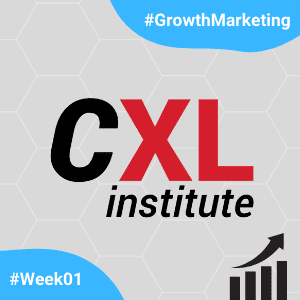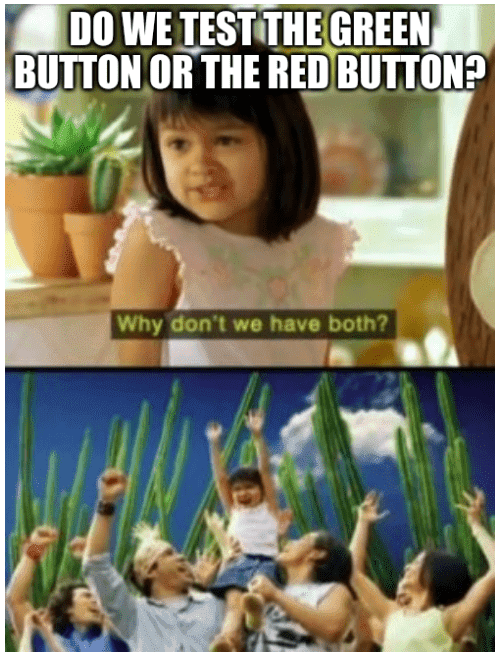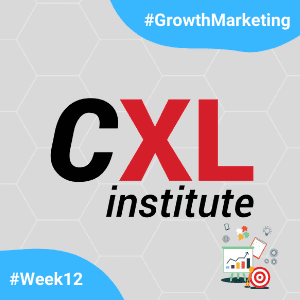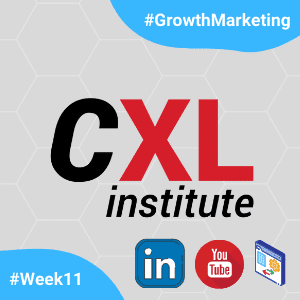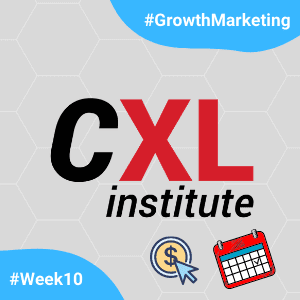Good news!
Starting this week, I am officially part of the CXL Institute Scholarship Program! For the next 12 weeks, I will create and share content related to the Growth Marketing Minidegre, in which I am enrolled.
I have just finished my first week of the course and I'm excited to start with the content! I will make the contents available in English and will release a translated version in Brazilian Portuguese.
CXL Institute and its Scholarship Program
Before going deeper into Growth Marketing subjects and the reason for all these texts, full of “buzzwords”, it is relevant to clarify what the CXL Institute is and how its Scholarship Program works. So come on.
The CXL Institute (short for Conversion XL) is an educational entity whose mission is to democratize the know-how of the best marketing techniques available on the market. To this end, the institution brings the top 1% marketers in the world to pass on their knowledge. And the team of instructors really lives up to that promise, starting with the entity's founder, Peep Laja, elected by PPC Hero as the most influential CRO Expert in the world (2015).
To achieve the goal of democratizing this knowledge without cost being a problem, the institution created the Scholarship Program, in which the beneficiary has access to one of the 6 mini-degrees offered by the institution:
- Content Marketing - 24h
- Conversion Optimization - 72h
- Customer Acquisition - 57h
- Digital Analytics - 40h
- Digital Psychology and Persuasion - 44h
- Growth Marketing - 102h
Each minidegree consists of a specific combination of courses, all taught by some of the best professionals within each area. Currently, June 2020, there are 48 courses available on the platform, with content such as “Advanced Google Tag Manager”, “A / B testing mastery”, “Authentic Storytelling”, among others. The content of the courses varies from more technical topics, such as how to produce and deliver content or the operation of specific tools (Google Ads, Analytics), to more comprehensive and strategic topics, such as the “Ecommerce Growth” course.
I was immediately interested in all of the minidegrees!
But I made my initial choice.
About a year and a half ago, I got together with a great Growth Professional to create Masteradin, a Digital Marketing consultancy focused on leveraging the growth of small and medium companies in the online universe. Despite my 7 years of experience working with Business Intelligence in the industry sector and my newly acquired ability to automate processes with programming, there was still a barrier of technical knowledge to be overcome in the universe of Growth Marketing.
For the past few years I have studied. Every day. I read about different topics, applied strategies and even got some results. However, I saw in the Growth Marketer Minidegree as an opportunity to advance to the next level within the area. Opportunity to refine knowledge acquired through day-to-day practice and have the chance to be part of 1%.
What is Growth Marketing and why is it relevant?
Knowing how Growth Marketing differs from Traditional Marketing is the first step to understand the relevance of this training. The fundamental distinction is about the sales funnel. While the traditional strategy focuses on the top of the funnel, reaching large numbers of people, the growth-oriented strategy values experimentation and is guided by available data in order to reach the right person, in the right place with the most appropriate message, adapting the approach to the part of the funnel that person is.
To illustrate the situation, we can imagine, for example, a company that sells men's dress shoes. A few decades ago, if this brand wanted to promote its products, an ad on TV or in newspapers / magazines would be some of the most coveted channels. After a certain period, the company would analyze its sales numbers and identify whether the campaign was successful or not. These were the data available. This is the option available for Traditional Marketing.
If the same company operated with the same product these days, it could, for example, use an ad strategy geared towards the social media channel. Ads could be targeted by gender, similar tastes, age group, among others. Then, right after the campaign was carried out, it would be possible to identify exactly which type of user reacted most to the advertisiments and, consequently, in which consumer profile the company should invest more time, effort and money.
Does this mean that traditional forms of marketing are obsolete and should be discarded? No, but they must definitely be adapted to encompass the new information available and use it in the best way. Growth Marketing, based on experimentation and data-driven, opens up possibilities that go beyond what the traditional marketing offers. The experimentation practice is empowered by the technological resources available and allows new frontiers to be explored. Today, it is even possible to determine through statistical tests whether a call to action button should be green or red (using A / B tests in Google Tag Manager, for example. But we will talk about this later in the next weeks). There are tools for that. Simple and efficient use.
- Why not both?
The speed of technological advancement should, for itself, be sufficient reason to justify studying Growth Marketing. In addition, though, there is still a simple reason for stimulating the understanding and applying of such techniques: the opportunity cost of not applying them.
The world's largest companies in different sectors have been investing in technological solutions that bring information. The global e-commerce giants, for example, have teams and teams composed of professionals trained in increasingly specific functions. Professionals who only take care of one specific social network, or who analyze only the user experience on a sales page, or who only take care of the loading speed of a part of the website, among others.
When the experimentation marketing is not being applied, companies not only fail to benefit from an eventual leverage in sales from a specific marketing action, but they also leave free space for their competitors, who can occupy that space without great efforts and grow their sales.
Having identified the importance of Growth Marketing, we can analyze the structure of the CXL course and how they are willing to pass on this knowledge.
The Growth Marketing Minidegree is divided into 7 parts, in addition to a final exam, and these parts are subdivided into 32 courses. The parts are:
- Growth Marketing foundations
- Running growth experiments
- Data and analytics
- Conversion
- Channel-specific growth skills
- Growth program management
- Management
In the first of my 12-week course, I completed the “Growth Marketing Foundations” section, which is divided into 4 courses. Below, the description of the courses and some of the main insights:
Growth mindset: growth vs traditional marketing
Instructor: John McBride
Main insight:
Growth Marketing focus on the entire funnel, differently than Traditional Marketing, that aims on the top of the funnel. Understanding that customers are different is key for being able to provide the best experience with the right message for each one of them.
Building a growth process
Instructor: John McBride
Main insight:
This section focuses on the importance of correctly mapping the consumer journey and identifying all channels for growth. With this information well established, the instructor points out the stages of Quarterly planning, in which the objectives must be established and inserted in a roadmap and that of In-quarterly planning, with the construction, addressing and analysis of the determined experiments.
User-centric marketing
Instructor: Paul Boag
Main insight:
Knowing the audience is essential. Understanding the journey of users of a product is crucial to correctly direct marketing actions. To get to know the public, you can use efficient surveys (short and simple) or search for information within the company itself, through the sales team, customer support, social media, analytics and other informational data.
Identifying and amplifying growth channels
Instructor: Sophia Eng
Main insight:
Content Marketing of the best channels to start is what unites Social, SEO, PPC, PR and Email. Through content, users come to understand the brand language and can start interacting with the product / service, in addition to being useful for brand awareness.
The introduction to the theme in this first week was enough to raise expectations for the next modules. The instructors are excellent and the content is stimulating. I look forward to the next 11 weeks. Thank you for joining me on this one.
